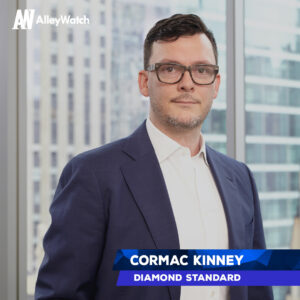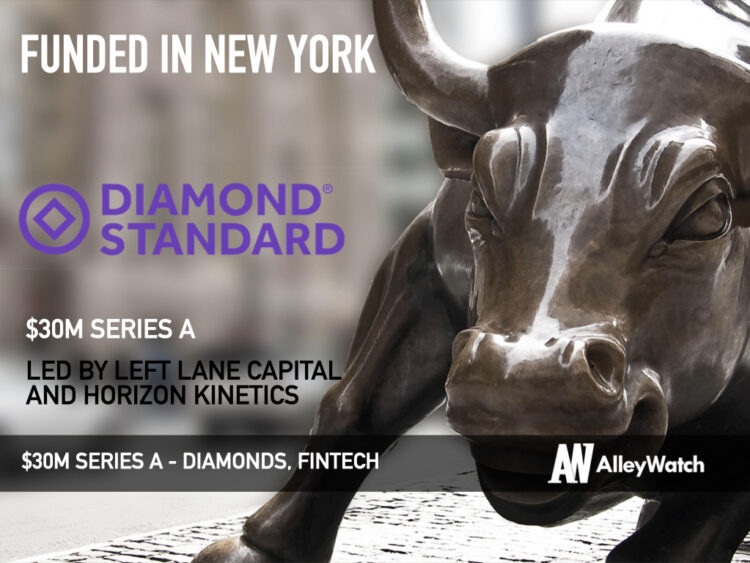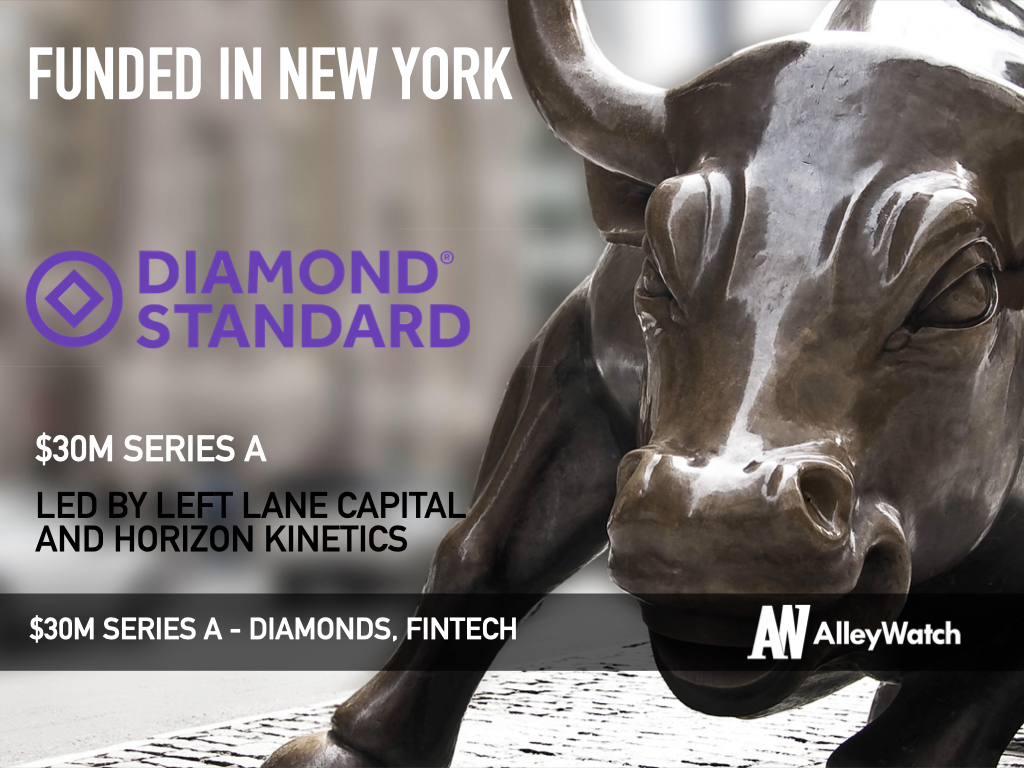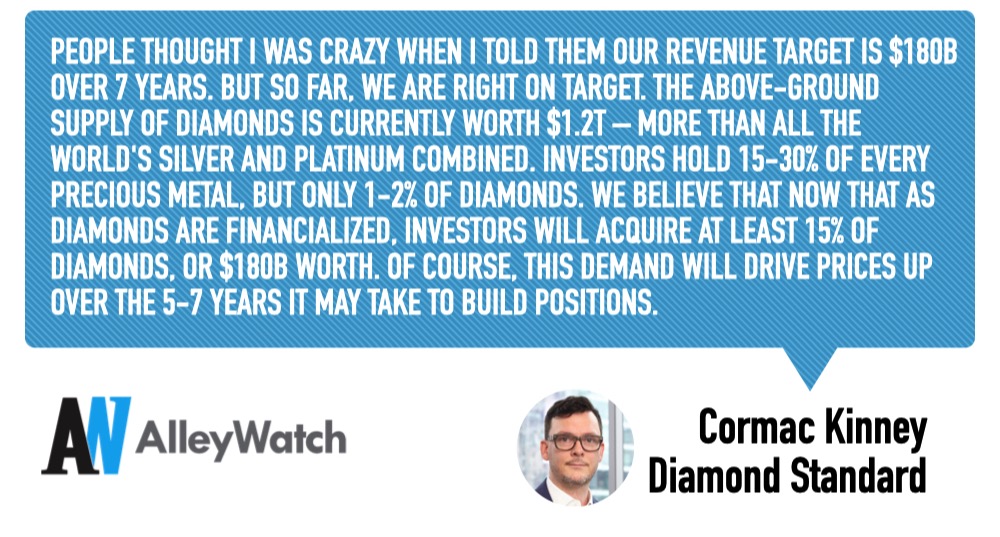Commodities have outperformed the overall financial markets during the most recent downturn and have traditionally served as a primary hedge for inflation. The typical classes of investable commodities include energy, agricultural and livestock, and metals. For precious metals, the most commonly sought resource, diamonds, have not been investable due to differentiation between stones. Diamond Standard has developed the world’s regulator-approved mechanism to invest in physical diamonds supported by its own spot market. The startup has also developed its own fund for investors that prefer to invest in shares and is in the process of launching its own futures product. Each diamond is graded by both the GIA and International Gemological Institute and tokenized on the blockchain, allowing them to be freely traded for a 3.5% fee.
AlleyWatch caught up with Diamond Standard CEO and Founder Cormac Kinney to learn more about the business, the company’s strategic plans, latest round of funding, which brings the total funding raised to $54M, and much, much more…
Who were your investors and how much did you raise?
We raised a $30M Series A round. Horizon Kinetics and Left Lane Capital were lead investors. Gaingels and Republic.co also invested, alongside other private investors.
Tell us about the product or service that Diamond Standard offers.
Investors generally hold at least 15% of all precious metals. For centuries diamonds have been an attractive and scarce natural resource, but inaccessible to investors because of the lack of price transparency and liquidity. Diamond Standard has unlocked the world’s $1.2T diamond supply as an asset for the first time through the development of regulator-approved fungible commodities – the Diamond Standard Coin and Bar. These physical assets contain a standardized set of diamonds in crystal clear plastic, and can be held by the owner, or by a custodian like Brinks. Inside the plastic is a wireless encryption chip that enables audit, authentication and blockchain-based trading. While held by a custodian, owners can trade the commodity using the token on the Diamond Standard Spot Market. For those investors that prefer to invest in shares, as opposed to a physical commodity, we offer the Diamond Standard Fund. Finally, the Diamond Standard commodities have been approved to settle diamond futures in development by MGEX™ to list on the CME Globex® platform, and options on MIAX™.
 What inspired the start of Diamond Standard?
What inspired the start of Diamond Standard?
I am a serial fintech entrepreneur –I love to develop ideas and build technology. I’ve launched seven startups and achieved four public exits, and my inventions have been cited in over 4,000 patents – referring to other patents building upon my innovations. After selling a trading systems development firm, I ran quant-driven strategies for hedge fund heavyweights Paul Tudor Jones and Izzy Englander at Millenium. My entrée into the diamond market came via my wife, Mimi So, an influential jewelry designer, and from her I learned all about diamonds. I realized that they could be standardized using computer science, basically all of the fintech that I’ve used for 20 years.
How is Diamond Standard different?
It’s impossible to categorize Diamond Standard. We are mostly a technology developer, and one of the most sophisticated blockchain users in the world. We are also a diamond-exchange operator and market maker, and manufacturer – all in a regulated entity. Our main job is to be the primary dealer – the company that bids on millions of diamonds to produce the exact same commodity every week.
What market does Diamond Standard target and how big is it?
People thought I was crazy when I told them our revenue target is $180B over 7 years. But so far, we are right on target. The above-ground supply of diamonds is currently worth $1.2T – more than all the world’s silver and platinum combined. Investors hold 15-30% of every precious metal, but only 1-2% of diamonds. We believe that now that as diamonds are financialized, investors will acquire at least 15% of diamonds, or $180B worth. Of course, this demand will drive prices up over the 5-7 years it may take to build positions. Many of our investors are looking forward to the day that diamonds are added to the commodity indices, which will trigger a stampede of sovereign wealth funds, endowments, and institutional investors.
What’s your business model?
We sell a market-traded commodity and collect a 3.5% fee on every diamond that goes through our exchange.
How are you preparing for a potential economic slowdown??
Ramping up production capacity as quickly as possible. Commodities historically perform best in periods of inflation. We just started construction on our second facility to bring our capacity up to $3B per year. We are also preparing to launch Diamond Standard Recycling which will be the largest used jewelry buyer in the world.
What was the funding process like?
As a serial entrepreneur, I funded the majority of Diamond Standard’s early development, and since then we were able to attract very strategic investors after we had a working prototype and regulatory approval, and several patents. Raising cash at that point was the easiest of any company I have launched. There is lots of capital for a great new idea – especially a giant swing like financializing the $1.2 trillion diamond market.
What are the biggest challenges that you faced while raising capital?
Regulatory approval was a two-year mountain climb, but once we had that, it was much easier. With several successful exits, I’m not the normal entrepreneurial story.
What factors about your business led your investors to write the check?
I could put a regulator-approved diamond commodity in their hand, and they could sell it for 99.5% of the market price, in 5 minutes.
What are the milestones you plan to achieve in the next six months?
With our Spot Market now live and the Diamond Standard Index (DIAMINDX) now listed on Bloomberg, our goals are to launch new vehicles and distribution channels to enable investors to get exposure to this uncorrelated asset class. With the capital injection from the raise, we are hiring in the sales and marketing areas, and building a much larger production and recycling facility in New York.
With our Spot Market now live and the Diamond Standard Index (DIAMINDX) now listed on Bloomberg, our goals are to launch new vehicles and distribution channels to enable investors to get exposure to this uncorrelated asset class. With the capital injection from the raise, we are hiring in the sales and marketing areas, and building a much larger production and recycling facility in New York.
What advice can you offer companies in New York that do not have a fresh
injection of capital in the bank?
Get to a minimum viable product that can be used to showcase your offering, share it with as many people as possible to get feedback. Drop anything that is not a very large opportunity – it is much easier to raise big capital for a big idea, than the reverse. Your time is too valuable to waste on a small idea.
Where do you see the company going now over the near term?
Now that diamonds are being financialized, we expect the market to develop all the same vehicles and services as there are available for gold, such as brokers, market makers, spot trading on exchanges, futures, options, exchange-traded funds, sales and trading at banks, and margin and lending — our job is to consistently provide the underlying spot commodity. We also have plans to create a Diamond Recycling center in the heart of Manhattan and have acquired more office space to build this business out.
What’s your favorite restaurant in the city?
My wife loves to try new restaurants every week, and the latest favorite is Fasano on Park, but she’s in fashion so L’Avenue at Saks is a regular spot.






